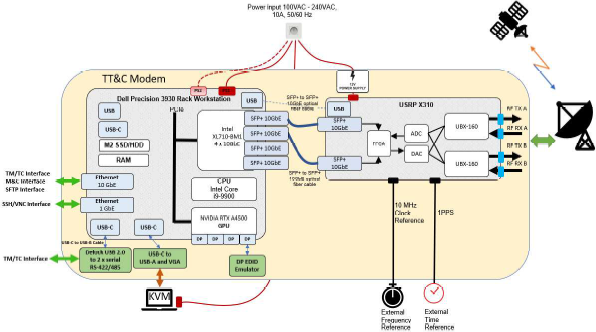PAGE CONTENTS
Objectives
The objective of the project is to develop a Software Defined Radio (SDR) Modem for addressing Telemetry, Tracking and Command (TT&C) functions in satellite testing Electrical Ground Support Equipment (EGSE) systems and simulation environments for telecom market and ground stations market.
The project is starting from the existing prototype work (from former GSTP activity), which is for the implemented features mainly on TRL5, with the Technology Phase to add missing modem functionality and enhance the existing prototype to bring all features to TRL5/6.
In the next step, the Product Phase shall productise the SDR Modem (all features shall be fully implemented, all admin functions shall be available, all features shall be verified and validated on module and system level up until TRL8).
The figure below shows the main components of Terma’s SDR Modem. Terma’s SDR Modem is a distributed system that consists of a generic hardware backend (rack mounted Dell workstation) connected to an RF frontend (Ettus USRP X310) via SFP+ optical cables, capable of dual 10Gbps connections. The RF frontend can be positioned close to the antenna to reduce signal loss, while the backend can be located in a server room.

Challenges
The main challenges were found in the SDR technology, implementation of the required capabilities, modulation types (BPSK/PM, OQPSK, GMSK), Turbo coding, Doppler correction and Impairments correction, Ranging as well as the related performances.
Another challenge was the selection of the baseline solution (HW and SW platform). The main criteria was the processing performance, cost and the portability of the implementation, as the SDR Modem is desired to be as much as possible HW independent.
System Architecture
Terma’s SDR Modem is a distributed system that operates on generic hardware. The backend controller PC (rack mounted Dell workstation) is connected to an RF frontend (Ettus USRP X310) via SFP+ optical cables, capable of dual 10Gbps connections. The RF frontend can be positioned close to the antenna to reduce signal loss, while the backend can be located in a server room, allowing for multicore, multithreaded processing, real-time scheduling, a Linux operating system, C++ and Python programming, and GUI with flowgraphs.
The figure below shows the SDR Modem architecture and internal an external interfaces.

Plan
Technology Phase was used to de-risk the SDR Modem functionality and to enhance the existing prototype to bring all features to TRL5/6. Technology Phase will be completed in June 2024.
The Product Phase which then starts shall productise the SDR Modem. All features shall be fully implemented, all admin functions shall be available, all features shall be verified and validated on module and system level up until TRL8. After 10 months the Final Review is scheduled.

Current Status
Currently the test and verification of the main SDR Modem functionality is still ongoing. Phase Closure of the Technology Phase is scheduled in the upcoming weeks.

